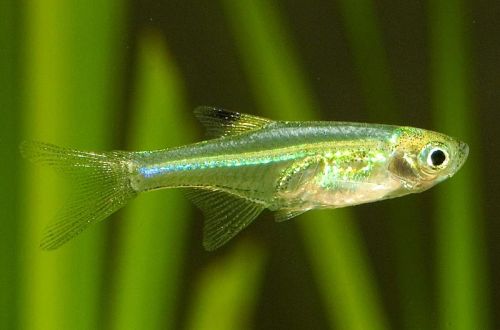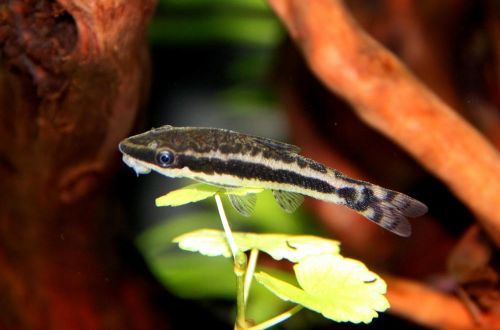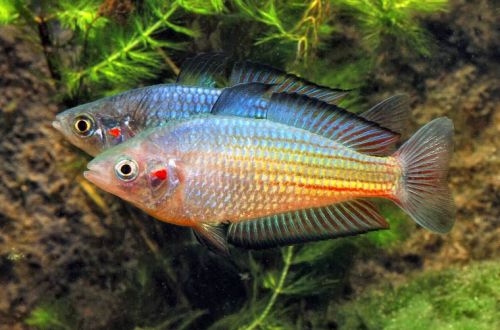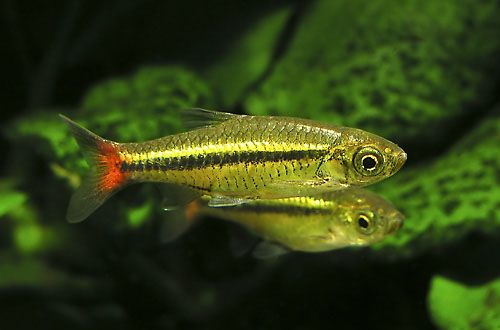
Dwarf Danio
The green dwarf zebrafish, scientific name Microdevario nana, belongs to the family Cyprinidae (Cyprinidae). Previously, until 2009, this fish belonged to the Rasbor group and was called the Green Dwarf Rasbora, but later studies have shown that this species belongs to the Danio. Nevertheless, both names are still actively used and can be considered synonyms.

Contents
Habitat
It comes from Southeast Asia from the territory of southern Myanmar (Burma). It is found mainly in the delta of the Ayeyarwaddy River. This area is very swampy and dotted with many streams and channels. The natural habitat is characterized by muddy water due to suspended silt and an abundance of aquatic vegetation. A significant part of the region fell under human economic activity, rice fields spread over vast expanses, which became the second home for the Green Dwarf Danio.
Brief information:
- The volume of the aquarium – from 40 liters.
- Temperature – 20-27°C
- Value pH — 6.0–7.5
- Water hardness – 1–12 dGH
- Substrate type – any soft
- Lighting – subdued
- Brackish water – no
- Water movement – light or moderate
- The size of the fish is about 1.5 cm.
- Feeding – any food of suitable size
- Temperament – peaceful
- Keeping in a group of 8-10 individuals
Description
Outwardly similar to their closest relatives – Danio Gates and Mikrorasboru kubotai, but differs in smaller sizes, only about one and a half centimeters, and a dark mark on the dorsal fin. The color is silvery with green tints. Sexual dimorphism is weakly expressed. There are no obvious differences between males and females.
Food
Accepts all types of popular food of suitable size, designed for aquarium fish. The daily diet may consist of dry flakes, granules combined with live or frozen brine shrimp, daphnia, bloodworm pieces.
Maintenance and care, arrangement of the aquarium
Such miniature fish can be content with an aquarium from 40 liters. The design is simple, the main condition is the presence of a large number of aquatic plants, both rooting and floating. The latter will provide the necessary shading, in which the emerald shades of the Green Dwarf Danio will look most impressive. The lighting is subdued.
Fish do not tolerate strong and even moderate currents, which should be taken into account when choosing the type of filter, which is the main cause of water movement in the aquarium. If the number of inhabitants is not large, then the best solution is to use an airlift filter with a sponge as a filter material. It practically does not cause internal flow, perfectly purifies water and saturates it with oxygen. The disadvantage is low productivity and low efficiency with large fish.
In the case of a large number of living plants, it may be necessary to install additional aerator pebbles to avoid oxygen starvation at night, since photosynthesis stops at night and plants begin to actively release carbon dioxide consumed earlier in the day.
The maintenance and maintenance of the aquarium consists of several standard procedures, including at least a weekly replacement of part of the water with fresh water, removal of organic waste (experiments, food residues) and plaque, maintenance of equipment, control and maintenance of stable pH and dGH values.
Behavior and Compatibility
Peaceful schooling fish, it is desirable to maintain a group size of at least 8-10 individuals. Compatible with other types of comparable size. Any large fish are potential dangers and should be avoided.
Breeding / breeding
At the time of writing, no reliable information was found on successful cases of breeding this species in a home aquarium. However, given the close relationship with the Kubotai Mikrorasbora, it can be assumed that there are similarities in the features of reproduction.
Under favorable conditions, spawning occurs regularly throughout the year. The fish scatter many eggs among the thickets of plants, they do not show concern for the offspring, and on occasion they will definitely eat their own offspring. Fry may appear in the main aquarium, but if they are not transplanted into a separate tank, then only a few will survive to adulthood.
Fish diseases
In a balanced aquarium ecosystem with species-specific conditions, diseases rarely occur. Often, diseases are caused by environmental degradation, contact with sick fish, and injuries. If this could not be avoided and the fish shows clear signs of illness, then medical treatment will be required. Read more about symptoms and treatments in the Aquarium Fish Diseases section.





